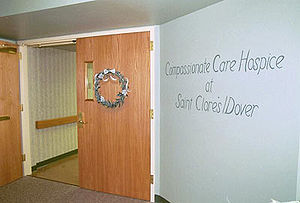
In the United States, hospice care is a type and philosophy of end-of-life care which focuses on the palliation of a terminally ill patient's symptoms. These symptoms can be physical, emotional, spiritual or social in nature. The concept of hospice as a place to treat the incurably ill has been evolving since the 11th century. Hospice care was introduced to the United States in the 1970s in response to the work of Cicely Saunders in the United Kingdom. This part of health care has expanded as people face a variety of issues with terminal illness. In the United States, it is distinguished by extensive use of volunteers and a greater emphasis on the patient's psychological needs in coming to terms with dying.
Under hospice, medical and social services are supplied to patients and their families by an interdisciplinary team of professional providers and volunteers, who take a patient-directed approach to managing illness. Generally, treatment is not diagnostic or curative, although the patient may choose some treatment options intended to prolong life, such as CPR. Most hospice services are covered by Medicare or other providers, and many hospices can provide access to charitable resources for patients lacking such coverage.
With practices largely defined by the Medicare system, a social insurance program in the United States, and other health insurance providers, hospice care is made available in the United States to patients of any age with any terminal prognosis who are medically certified to have less than six months to live. In 2007, hospice treatment was used by 1.4 million people in the United States. More than one-third of dying Americans use the service. Common misperceptions regarding the length of time a patient may receive hospice care and the kinds of illnesses covered may result in hospice being underutilized. Although most hospice patients are in treatment for less than thirty days, and many for less than one week, hospice care may be authorized for more than six months given a patient's condition.
Care may be provided in a patient's home or in a designated facility, such as a nursing home, hospital unit or freestanding hospice, with level of care and sometimes location based upon frequent evaluation of the patient's needs. The four primary levels of care provided by hospice are routine home care, continuous care, general inpatient, and respite care. Patients undergoing hospice treatment may be discharged for a number of reasons, including improvement of their condition and refusal to cooperate with providers, but may return to hospice care as their circumstances change. Providers are required by Medicare to provide to patients notice of pending discharge, which they may appeal.
In other countries, there may not be the same distinctions made between care of those with terminal illnesses and palliative care in a more general setting. In such countries, the term hospice is more likely to refer to a particular type of institution, rather than specifically to care in the final months or weeks of life. End-of-life care is more likely to be included in the general term "palliative care".
© MMXXIII Rich X Search. We shall prevail. All rights reserved. Rich X Search
